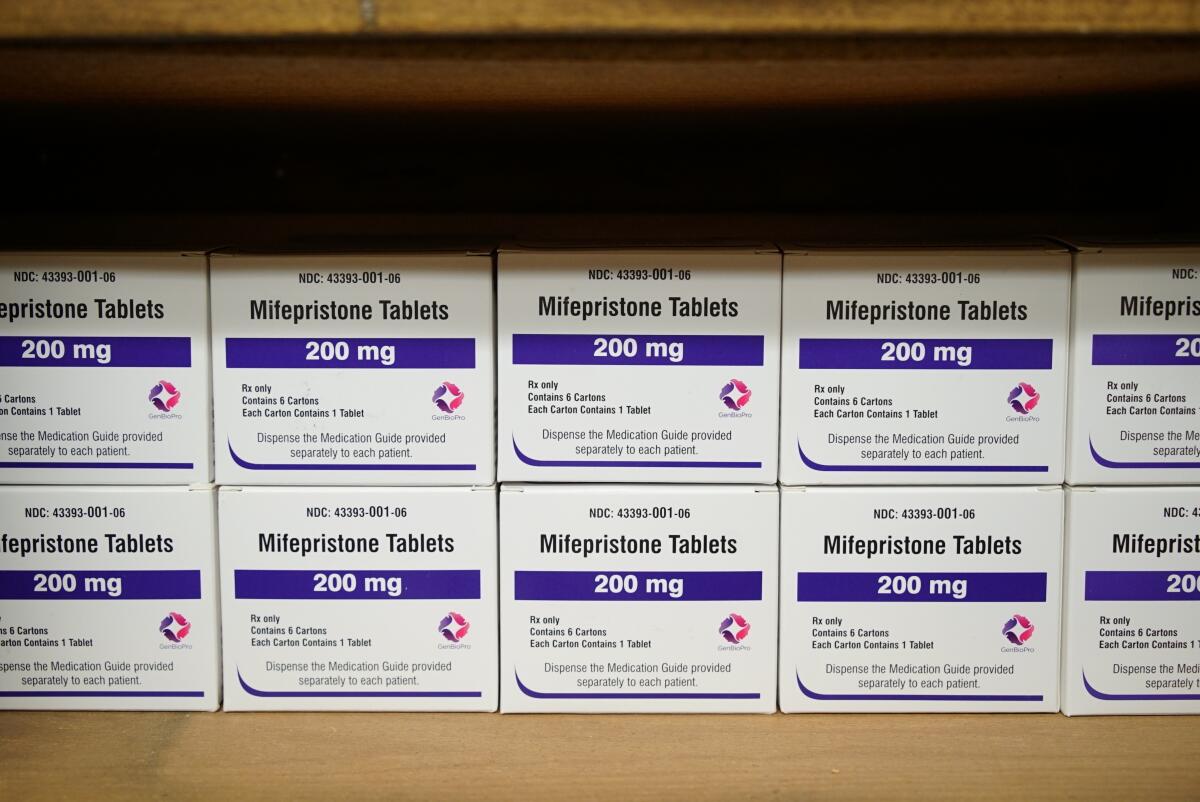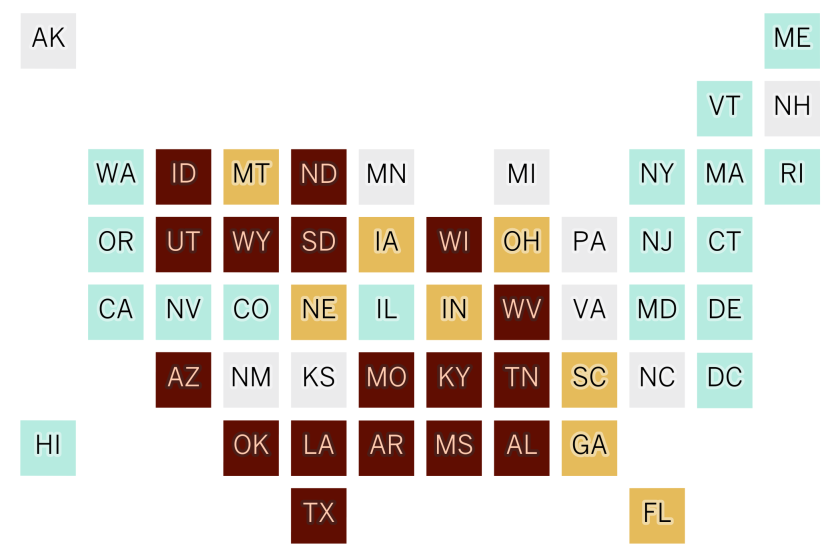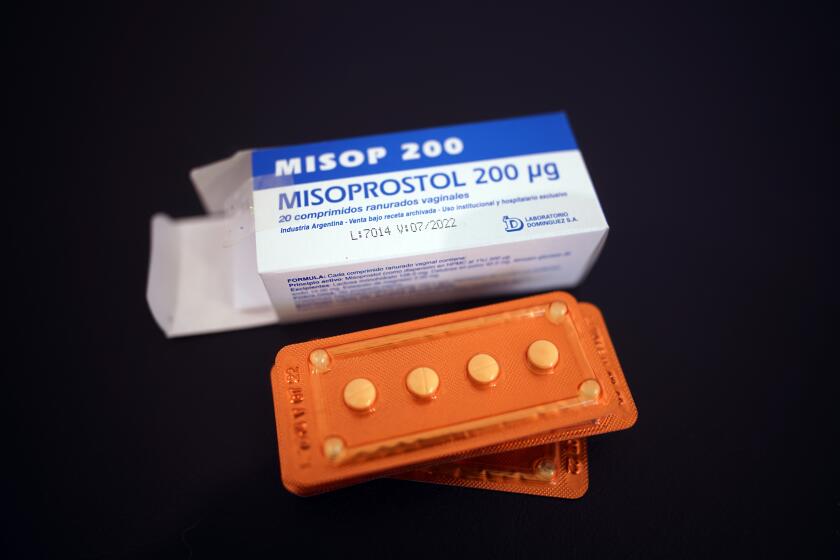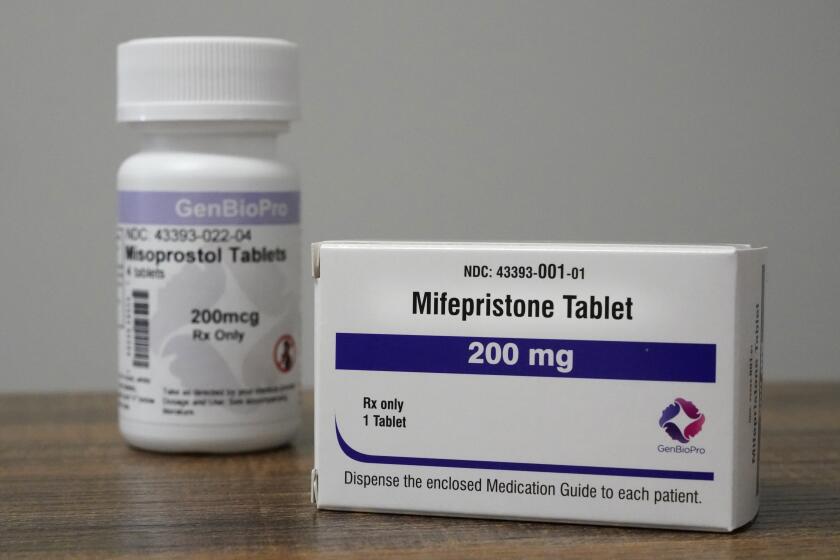Medication abortion is common. Here’s how it works

- Share via
Medication abortions became the preferred method for ending pregnancy in the U.S. even before the Supreme Court overturned Roe vs. Wade. These involve taking two prescription medicines days apart — at home or in a clinic.
Abortion procedures are an invasive medical technique that empties the womb. They are sometimes called surgical abortions, although they don’t involve surgery.
Abortion by pills involves the drugs mifepristone and misoprostol. As more states seek abortion limits, demand for the pills is expected to grow.
How the drugs work
Mifepristone is taken first, swallowed by mouth. The drug dilates the cervix and blocks the effects of the hormone progesterone, which is needed to sustain a pregnancy.
Misoprostol, a drug also used to treat stomach ulcers, is taken 24 to 48 hours later. The pill is designed to dissolve when placed between the gums and teeth or in the vagina. It causes the uterus to cramp and contract, causing bleeding and expelling pregnancy tissue.
Ahead of an expected Supreme Court decision on Roe vs. Wade, medication abortions have surged — and drawn the interest of opposition groups.
How the drugs are used
Abortion medication is approved for use up to the 10th week of pregnancy.
The pills may be taken in a doctor’s office or clinic, where patients sometimes have an ultrasound or lab tests beforehand. Some providers also offer the pills through telehealth visits and then send patients the medication by mail.
Use of the pills has been increasing in recent years. As of 2020, they accounted for 54% of all U.S. abortions, according to preliminary data from the Guttmacher Institute. The group’s final estimate is due later this year.
Side effects
Studies and real-use evidence show that when taken together, the pills are safe and up to 99% effective. Side effects may include nausea, vomiting and diarrhea.
Bleeding is normal. Very heavy bleeding — soaking more than two pads an hour for more than two hours — is uncommon and requires medical attention.
With the Supreme Court expected to rule on Roe vs. Wade in the coming months, a Colorado abortion provider has recommitted himself to what he says is his life’s work: helping women.
Dr. Stephanie Rand, a New York ob-gyn and abortion specialist with the advocacy group Physicians for Reproductive Health, says pregnancy tests should not be used right away to determine if a medication abortion was successful because the pregnancy hormone may linger in the body for several weeks. Bleeding, with blood clots that include lighter colored tissue, are signs of success, she said.
Serious complications are very rare. The Food and Drug Administration says more than 3.7 million U.S. women have used mifepristone since it was approved more than 20 years ago. The agency has received 26 reports of deaths in women using the medication, including two involving ectopic pregnancies, which grow outside the womb.
The medications are not recommended for certain patients, including those with suspected ectopic pregnancies or with implanted IUD birth control devices.
Costs
Costs vary by location but are similar to abortion procedures and may total more than $500. Health insurance coverage varies, with some plans making the pills free or low cost and others not covering them at all.
Mifepristone is sold under the brand name Mifeprex and misoprostol under the brand name Cytotec, but both pills are available as generics.
Federal rules
The FDA approved mifepristone to terminate pregnancy in 2000, when used with misoprostol. At the time, it imposed several limits on how the drug could be prescribed and dispensed.
In December, the agency dropped the biggest restriction: a requirement that patients pick up the medication in person. The FDA said a scientific review of the drug’s use — including during the COVID-19 pandemic — showed that women could safely receive the pills through the mail after an online consultation, without any increase in side effects or complications.
The decision allowed mail delivery of the pills nationwide, a change long sought by medical professional groups and abortion rights supporters.
Still, millions of women will have trouble accessing the pills due to a patchwork of state laws targeting abortion broadly and the pills specifically. About half of U.S. states are expected to ban or greatly restrict abortion as a result of the reversal of Roe vs. Wade.
The logistics of accessing abortion are about to get more complicated, with at least 26 states set to ban the procedure after the fall of Roe vs. Wade.
Legal conflicts
Legal experts foresee years of court battles over access to the pills as abortion rights proponents bring test cases to challenge state restrictions.
There are strong arguments and precedents on both sides, experts note, though little certainty about which side might prevail.
The Biden administration’s Justice Department has already signaled plans to challenge state restrictions on medication abortion. And federal lawyers are likely to be joined by outside parties, including abortion rights groups like Planned Parenthood and even the companies that make the pills.
The chief argument against pill restrictions is likely to be the longstanding principle that federal laws, including FDA decisions, preempt state laws. Indeed, few states have ever tried to fully ban an FDA-approved drug because of past rulings in the agency’s favor.
Facebook and Instagram remove posts that offer abortion pills to women after the Supreme Court’s reversal of Roe vs. Wade.
Still, states with blanket abortion bans are likely to interpret them as barring abortion pills. Many of the laws don’t distinguish between abortion procedures and medication abortion.
“In the short term, those states that ban abortion are going to assume that their bans also include medication abortion and that will be prohibited,” said Greer Donley, a professor specializing in reproductive healthcare at the University of Pittsburgh Law School.
State law on the pills
Even if blanket bans are successfully challenged, more than 30 states have laws specifically restricting access to abortion pills. For example, 19 states require that clinicians be physically present when the drug is administered.
Those laws could withstand court challenges. States have long had authority over how physicians, pharmacists and other providers practice medicine.
States also set the rules for telemedicine consultations used to prescribe medications. Generally that means health providers in states with restrictions on abortion pills could face penalties, such as fines or license suspension, for trying to send pills through the mail.
States should not be able to ban FDA-approved abortion pills from being mailed to anyone in the United States.
Women have already been traveling across state lines to places where abortion pill access is easier. That trend is expected to increase.
Meanwhile, some women will still get the medication via online pharmacies in Canada and overseas, often with telehealth consultations from foreign doctors. The practice is technically illegal but essentially unenforced, and advocates believe women will increasingly choose this method as more states move to ban abortions.
“Anti-abortion states are going to do everything they can to restrict medication abortion, but practically speaking people have been and will continue to access it through the mail from international pharmacies,” Donley said.
Years of uncertainty
Donley expects lawsuits based on various legal theories to play out for a few years before any clear decisions emerge.
One key question is how the nation’s top court might rule if and when it takes up those court cases. While the Supreme Court has rejected a constitutional right to abortion, conservative justices have also generally deferred to the FDA’s primacy over drug decisions.











